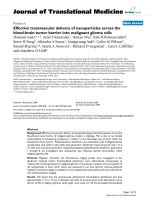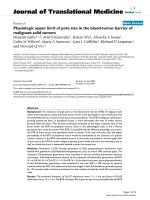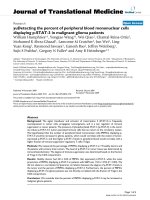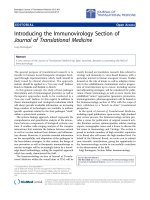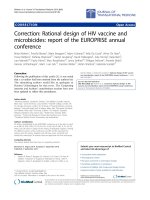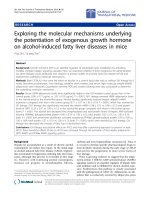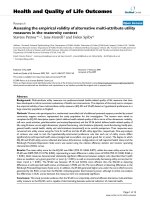báo cáo hóa học: " Exploring the validity of estimating EQ-5D and SF-6D utility values from the health assessment questionnaire in patients with inflammatory arthritis" potx
Bạn đang xem bản rút gọn của tài liệu. Xem và tải ngay bản đầy đủ của tài liệu tại đây (224.28 KB, 8 trang )
RESEARC H Open Access
Exploring the validity of estimating EQ-5D and
SF-6D utility values from the health assessment
questionnaire in patients with inflammatory
arthritis
Mark J Harrison
1
, Mark Lunt
1
, Suzanne MM Verstappen
1
, Kath D Watson
1
, Nick J Bansback
2
,
Deborah PM Symmons
1*
Abstract
Background: Utility scores are used to estimate Quality Adjusted Life Years (QALYs), applied in determining the
cost-effectiveness of health care interventions. In studies where no preference based measures are collected,
indirect methods have been developed to estimate utilities from clinical instruments. The aim of this study was to
evaluate a published method of estimating the EuroQol-5D (EQ-5D) and Short Form-6D (SF-6D) (preference based)
utility scores from the Health Assessment Questionnaire (HAQ) in patients with inflammatory arthritis.
Methods: Data were used from 3 cohorts of patients with: early inflammatory arthritis (<10 weeks duration);
established (>5 years duration) stable rheumatoid arthritis (RA); and RA being treated with anti-TNF therapy.
Patients completed the EQ-5D, SF-6D and HAQ at baseline and a follow-up assessment. EQ-5D and SF-6D scores
were predicted from the HAQ using a published method. Differences between predicted and observed EQ-5D and
SF-6D scores were assessed using the paired t-test and linear regression.
Results: Predicted utility scores were generally higher than observed scores (range of differences: EQ-5D 0.01 -
0.06; SF-6D 0.05 - 0.10). Change between predicted values of the EQ-5D and SF-6D corresponded well with
observed change in patients with established RA. Change in predicted SF-6D scores was, however, less than half of
that in observed values (p < 0.001) in patients with more active disease. Predicted EQ-5D scores underestimated
change in cohorts of patients with more active disease.
Conclusion: Predicted utility scores overestimated baseline values but underestimated change. Predicting utility
values from the HAQ will therefore likely underestimate the QALYs of interventions, particularly for patients with
active disease. We recommend the inclusion of at least one preference based measure in future clinical studies.
The assessment of the cost-effectiveness of health care
interventions has become increasingly important as
health care providers aim to select the treatments and
interventions which maximise health gain from their
scarce resources. Assessments based on quality-adjusted
life years (QALYs) are used to compare the benefits of
interventions across medical conditi ons. The calculation
of QALYs involves weighting duration of life by a pre-
ference-based measure o f the health-related quality of
life (HRQol) experienced. Preferenc e based measures are
based on methods to val ue health states using simulated
choices between alternative health states: an individual
considers a transition from a defined health state to
some alternative (usually preferable) health state which
involves a sacrifice of something they value, for example
life expectancy, or a risk of an unfavourable event such
as death. The greater the sacrifice or risk accepted to
make the transition, the lower the valuation of the
defin ed health state [1]. Pr eference based measures pro-
vide a value (known as utility), on a scale ranging from
1 (equivalent to full health) to 0 (equivalent to death)
* Correspondence:
1
The arc Epidemiology Unit, The University of Manchester, Oxford Road,
Manchester, M13 9PT, UK
Harrison et al. Health and Quality of Life Outcomes 2010, 8:21
/>© 2010 Harrison et al; licensee BioMed Central Ltd. This is an Open Access article distributed under the t erms of the Creative Commons
Attribution License ( ), which permits unres tricted use, distribution, and reproduction in
any medium, provided the original work is properly cited.
with the potential in some measures for states consid-
ered ‘ worse than d eath.’ The calculation of cost per
QALY as a basis for assessing the cost-effectiveness of a
treatment has been adopted by organisations evaluating
and recommending treatments in many countries
including the UK [2] and the USA[3]
Preference based measures such as the EuroQol-5D
(EQ-5D) [4] and the Short Form-6D (SF-6D)[5] which is
derived from the Short Form 36-Item Health Survey
(SF-36)[6]) collect information about the health status of
patients using self-administered questionnaires. The
health status of the patient is then linked to a societal
utility value, one aimed to be representative of the
values of the population of a particular country, which
is obtained via large valuation studies in the general
population which attribute a utility value to each possi-
ble health state described by the questionnaire.
In rheumatol ogy, most clinical studies incorporate the
Health Assessment Questionnaire Disability Index
(HAQ)[7], which is a condition-specific health status
measure that focuses on functional disability, a single
aspect of health. Condition-specific health status mea-
sures have limited use in economic evaluation because
comparison across therapeutic areas becomes almost
impossible. Since treatments for rheumatology have to
‘compete’ with treatments f or other dise ases, the com-
parison of cost-effectiveness using ge neric outcome
measures is essential.
Despite their importance, many studies do not collect
genericpreferencebasedutilitymeasures.Toovercome
this limitation, methods of estimating the utility values
of preference based measures from disease specific mea-
sures have been developed. In rheumatology, a model
has recently been developed which maps the HAQ to
the EQ-5D and SF- 6D for the purpose of estimating the
average utility of a cohort [8]. The use of mapping tech-
niques has been described as second-best compared to
primary collection of data [9], but remain one of the
most practical solutions available when no utility mea-
sure has be en collected. S ince the incl usion of prefer-
ence based measure s increases the number of items in
collected in a study, adding to patient burden, and are
often seen as less important than clinical outcome mea-
sures, it might also be deemed necessary to use these
mapping functions i n future studies. In these circum-
stances, the performance of the mapping function in
estimating utility values needs to be assessed and the
likely impact of decisions based on these estimates con-
sidered. Data supporting the construct validity and
responsiveness of the SF-6D derived from the HAQ [8]
has been re ported in patients with early aggressive RA
[10]. However, to date there has been no evaluation of
EQ-5D values predicted from the HAQ, and neither
EQ-5D nor SF-6 D score s predicted from the HAQ have
to date been compared with actual measured values.
The aim of this study was to evaluate the published
method of estimating mean EQ-5D and SF-6D utility
scores from the Health Assessment Questionnaire
(HAQ), by comparing measured an d predicted values in
groups of patients with inflammatory arthritis with vary-
ing arthritis states and degrees of disease severity.
Methods
Patients and Setting
Data were taken from three cohorts of patients. The
first was The Steroids in Very Early Arthritis (STIVEA)
randomised controlled trial (RCT) of intramuscu lar ster-
oid treatment versus placebo in patients with very early
inflammatory arthritis (4-11 weeks duration). The trial
follow-up finished in late 2007 [11]. At the time of this
analysis, the STIVEA trial remained blinded. The trial
analysis has since shown that although treatment with
intramuscular steroids postponed the use of DMARDs
and prevented 1 in 10 patients with very early IP from
progressing to rheumatoid arthritis, there was no st atis-
tically significant difference between the two treatment
arms in any of the secondary outcome measures (which
included HAQ, the SF-36 and the EQ-5D) at 6-months
nor 12 months of follow-up [11].
The second cohort comprised patients from the Brit-
ish Rheumatoid Outcome Study Group (BROSG) RCT
of aggressive versus symptomatic control of inflamma-
tion in patients with established (>5 years duration)
stable, symptomatic rheumatoid arthritis (RA) followed
for three years. The BROSG trial was conducted
between 1998 and 2001 [12]. The BROSG trial found no
difference between treatment arms (aggressive versus
symptomatic tre atment aimed at suppressing inflamma-
tion) over a three year period. Thus, the dataset may be
considered a cohort of patients with established RA
whose RA deteriorated modestly over a three year per-
iod [6].
The third cohort was a sub-sample from the British
Society for Rheumatology Biologics Regist er (BS RBR) of
UK RA patients receiving anti-TNF therapy. The BSRBR
was established in October 2001, and the methods of
this study have been described in detail previously [13].
Briefly, the first 4000 RA patients starting each anti-
TNFa therapy were required by The National Institute
for Health and Clinical Excellence (NICE) to be regis-
tered with the BSRBR and followed up for information
on drug use, disease activity and adverse events. Routine
data collection includes the HAQ and SF-36. As part of
the current stud y, from 1
st
August 2006 to 31
st
Decem-
ber 2007, patients were also asked to complete the EQ-
5D at baseline and the 6 month assessment.
The data from these three cohorts reflect a wide range
of arthritis states/severity found in routine practice.
Harrison et al. Health and Quality of Life Outcomes 2010, 8:21
/>Page 2 of 8
Baseline data for all cohorts included age, sex and dis-
ease duration. Patients also completed the EQ-5D[4],
and the SF-36[6] which is used to calculate the SF-6D
utility measure[5]. The HAQ (adjusted for aids/devices
and help from others), a patient global assessment, the
28 tender and swollen j oint counts and the ery throcyte
sedimentation rate (ESR) were collected, and the Disease
Activity Score (DAS-28)[14] was calculated (Table 1).
Statistical Methods
Baseline characteristics were summarised and compared
between cohorts using the Kruskal-Wallis test for con-
tinuous variables and the Chi-square test for categorical
variables.
Estimated EQ-5D and SF-6D scores were calculated
from the HAQ, using the most successful of the map-
ping methods described in the article by Bans back et al.
[8]. The methods were developed cross-sectional data
from a cohort of 439 patients with a clinical diagnosis
of RA from two locations (308 participating in a study
in Vancouver, Canada (mean (SD) age 61.4 (13.7) year s,
78% female, mean (SD) disease d uration 14.0 (12.6)
years), and 131 participating in a study in Maidstone,
UK (mean (SD) age 56.0 (13.7) years). The mean (SD)
HAQ score of the patients used by Bansback et al.was
1.15 (0.78) and sc ores ranged from 0 to 3. EQ-5D and
SF-6D scores were estimated from items from the HAQ
using linear regression models estimated by generalised
estimating equation algorithms. Full regression equa-
tions for estimating the EQ-5D and SF-6D from the
HAQ are reported in the original study by Bansback, et
al. [8] and an example of how to use the algorithms is
available online http://www. pharmacoeconomics. ubc.ca/
download.html.
In this study, we estimated the EQ-5D using model 5
described by Bansback, et al., which was based on the
individual items of the HAQ, and treating each as a
categorical variable[8]. We estimated the SF-6D using
model 2 from the paper which used the 8 HAQ domain
scores, treated as a continuous variable[8]. These models
were reported to have the lowest mean square error and
the best predictive value of the five methods.
In order to investigate the relationship between the
HAQ and the EQ-5D and SF-6D as a basis for mapping,
we tested associations between the HAQ, EQ-5D and
SF-6D at baseline and for change over time using Spear-
man’s rank bec ause the HAQ and EQ-5D are non-nor-
mally distributed. The mean predicted and observed
EQ-5D and SF-6D scores were compared for each
cohort at baseline and in terms of the change between
baseline and the final follow-up. The mean differences
between predicted and observed values were calculated
and pre sented with 95% confidence intervals and a 9 5%
reference range, Differences between the mean observed
and predicted scores for a group were tested using the
paired t-test. The correlations of observed and predicted
values for each measure were assessed as an indicator of
the performance of the prediction model, using the R
2
statistic from a linear regression.
Results
Cross-sectional analysis
265 patients recruited to STIVEA, 466 to BROSG, and
866 patients from the BSRBR received a baseline EQ-5D
and SF-36 questionnaire. 1472 patients completed and
returned all the baseline questionnaires and were
included in this analysis; 224 (85%) of the STIVEA
cohort, 453 (97%) of the BROSG cohort, and 795 (92%)
of the BSRBR patients.
There were significant differences in demographic and
clinical characteristics between the three groups (Table
2). Patients from the BROSG study were older (median
62 years) than those f rom STIVEA (median 59 years)
and BSRBR (median 59 years) studies, and had lower
DAS28 scores (median: BROSG 4.0 vs. STIVEA 5.5 and
BSRBR 6.0) and lower median tender (median: BROSG
3 vs. STIVEA 9 and BSRBR 12) and swollen joint counts
(median: BROSG 3 vs. STIVEA 8 and BSRBR 7). There
was a trend of increasing HAQ score with increasing
disease duration (i.e. STIVEA>BROSG>BSRBR), but
Table 1 Summary of outcome measures used in this study
Type of measure Range of scores
Worst Best
EQ-5D Preference based utility measure/HRQoL -0.59 1.00
SF-6D Preference based utility measure/HRQoL 0.30 1.00
HAQ
†
Functional disability 3 0
DAS28
†
Disease activity 10 0
28 Tender joint count
†
Physician assessment of tenderness in 28 joints 28 0
28 Swollen joint count
†
Physician assessment of swelling in 28 joints 28 0
ESR (mm/hr)
†
Laboratory test of inflammatory marker/acute phase reactant * 0
Abbreviations: DAS28 = Disease Activity Score based on 28 swollen and tender joint counts, EQ-5D = EuroQol-5D, ESR = Erythrocyte Sedimentation Rate, HAQ =
Health Assessment Questionnaire, HRQoL = Health-Related Quality of Life, SF-6D = Short Form-6D
* Higher values indicate inflammation
Harrison et al. Health and Quality of Life Outcomes 2010, 8:21
/>Page 3 of 8
onlythedifferencebetween patients in the STIVEA
(median 1.3) and BSRBR (median (IQ R) 1.8) studies was
statistically significant (p < 0.001). There were propor-
tionally more women in t he BSRBR study (76%) than
the BROSG (68%) or STIVEA (72%) studies (p = 0.003).
Baseline corr elations of HAQ and EQ-5D scores ranged
from r = 0.63 (BROSG & BSRBR) to r = 0.69 (STIVEA),
and between HAQ and SF-6D from r = 0.58 (BROSG)
to r = 0.68 (STIVEA & BSRBR) (results not provided in
tables).
Overall, the predicted values of the SF-6D (R
2
0.34 -
0.51) scores were higher than for the EQ-5D (R
2
0.20 -
0.35), sugg esting t hat the SF-6D mapping model
explained more of the variance in observed scores
(Table 3). The predicted mean (SD) baseline E Q-5D in
BROSG patients did not differ from observed values
(EQ-5D: observed 0.59 (0.22) vs. predicted 0.59 (0.19), p
= 0.494). The predicted mean EQ-5D values were signif-
icantly higher than the observed values in STIVEA,
(observed 0.47 (0.31) vs. predicted 0.53 (0.25), p <
0.001) and those in the BSRBR (observed 0.40 (0.33) vs.
predicted 0.44 (0.26), p < 0.001). The variance around
all predicted utility values was consistently lower than
that around observed values i.e. the predicted values
were falsely precise.
Predicted SF-6D scores were consistently higher than
observed scores (Table 3) across all cohorts. The pre-
dicted mean baseline SF-6D for BROSG patients was a
small over-estimate (observed 0.63 (0.13) vs. predicted
0.68 (0.07), p < 0.001). However, predicted mean SF-6D
values were considerably higher than observed values in
STIVEA (observed 0.57 (0.13) vs. predicted 0.67 (0.07),
p < 0.001) or the BSRBR (observed 0.53 ( 0.11) vs. pre-
dicted 0.65 (0.06), p < 0.001).
Longitudinal analysis
Complete EQ-5D, SF-6D and HAQ details were avail-
able for 1283 patients at baseline and the final follow-up
assessment. The HAQ scores of patients in the STIVEA
trial (1 year mean change -0.38 (SD 0.66)) and BSRBR
study (6 mo nth mean change -0.27 (SD 0.87)) improved
over the follow-up period (results not provided in
tables). The mean HAQ score of patients in t he BROSG
trial deteriorated (3 year mean change 0.16 (SD 0.47)).
There was moderate correlation of change in HAQ with
change in EQ-5D in STIVEA (r = 0.58) and with change
in SF-6D in STIVEA (r = 0.68) and BSRBR (r = 0.53).
Lower correlations of change in HAQ and EQ-5D were
observedinBROSG(r=0.33)andBSRBR(r=0.42)
and with the SF-6D in BROSG (0.31) (results not pro-
vided in tables).
The R
2
values for the relationship between change in
observed and predicted SF-6D scores (R
2
0.11 - 0.46)
were once more higher than for the EQ-5D (R
2
0.08 -
0.22) (Table 4). Change in predic ted values of the EQ-
5D (mean difference 0.00, 95% CI -0.02, 0.03) and SF-
6D (mean difference -0.00, 95% CI -0.01, 0.01) corre-
sponded very well with observed change in patients
from the BROSG study, a group with established disease
Table 2 Baseline characteristics of patients from the
three cohorts, ranked by median HAQ score
STIVEA BROSG BSRBR
n = 224 n = 453 n = 795 p-
value*
Age (years) 59 (44, 66) 62 (53, 69) 59 (51, 67) <0.001
Disease duration
(years)
0.16 (0.12,
0.19)
11 (7, 16) 9 (3, 18) <0.001
Female gender, n(%) 160 (72%) 308 (68%) 604 (76%) 0.009†
HAQ 1.3(0.6, 1.6) 1.5 (0.9,
2.0)
1.8 (1.1,
2.1)
<0.001
DAS28 5.5 (4.8, 6.4) 4.0 (3.2,
4.9)
6.0 (5.1,
6.8)
<0.001
28-Tender joint
count
9 (5, 15) 3 (1, 8) 12 (6, 19) <0.001
28-Swollen joint
count
8 (5, 12) 3 (1, 6) 7 (4, 12) <0.001
Values are median (IQR) unless otherwise stated. * Kruskal-Wallis; † Chi-square
Abbreviations: BROSG = British Rheumatoid Outcome Study Group, BSRBR =
British Society for Rheumatology Biologics Register, DAS28 = Disease Activity
Score based on 28 swollen and tender joint counts, HAQ = Health Assessment
Questionnaire, STIVEA = Steroids In Very Early Arthritis,
Table 3 Comparison of baseline observed and predicted
utility scores
Observed Predicted Difference
(Observed-Predicted)
n Mean
(SD)
Mean
(SD)
R
2
Mean
(95% CI)
95% reference
range
EQ-5D
STIVEA 224 0.47
(0.30)
0.53
(0.25)
0.35 0.06
(0.02,
0.09)
-0.44 to 0.56
BROSG 453 0.59
(0.22)
0.59
(0.19)
0.20 0.01
(-0.01,
0.03)
-0.42 to 0.44
BSRBR 795 0.40
(0.33)
0.44
(0.26)
0.35 0.04
(0.02,
0.06)
-0.49 to 0.57
SF-6D
STIVEA 224 0.57
(0.13)
0.67
(0.07)
0.45 0.10
(0.09,
0.11)
-0.09 to 0.29
BROSG 453 0.63
(0.13)
0.68
(0.07)
0.34 0.05
(0.04,
0.05)
-0.16 to 0.25
BSRBR 795 0.53
(0.11)
0.63
(0.07)
0.51 0.09
(0.09,
0.10)
-0.06 to 0.25
Abbreviations: BROSG = British Rheumatoid Outcome Study Group, BSRBR =
British Society for Rheumatology Biologics Register, EQ-5D = EuroQol-5D, SF-
6D = Short Form-6D, STIVEA = Steroids In Very Early Arthritis
Harrison et al. Health and Quality of Life Outcomes 2010, 8:21
/>Page 4 of 8
(Table 4). The change in predicted and observed EQ-5D
scores was also very similar in patients receiving anti-
TNF therapy (mean difference -0.01, 95% CI -0.04, 0.01).
Predicted EQ-5D scores signific antly underestimated
change in patients with early arthritis (mean difference
-0.07, 95% CI -0.12, -0.03). The mean change in pre-
dicted SF-6D scores was less than half that in observed
values in pa tients with early arthritis (SF-6D: observed
0.13 (SD 0.16) vs. predicted 0.04 (SD 0.07), p < 0.001)
and severe RA (SF-6D: observed 0.05 (SD 0.12) vs. pre-
dicted 0.02 (SD 0.06), p < 0.001). There was no signifi-
cant difference in change using predicted a nd observed
SF-6D values in the BRSOG trial.
Discussion
We found that, using the method of Bans back et al.[8],
the validity of estimating utility scores from the HAQ var-
ies according to disease activity and duration. Predicted
values overestimated values cross-sectionally and underes-
timated change in patients with active arthritis, particularly
those with very early disease. These differences were clini-
cally significant; the difference between observed and pre-
dicted SF-6D exceeded the estimated minimum important
difference (MID) for this measure (0.03-0.04)[15] for all
cross-sectional baseline estimates and for change over 6
months in the very early disease group. Predicted SF-6D
values overestimated baseline values and underestimated
improvement in patients with active disease by approxi-
mately 60-70%. Similarly, the difference between observed
and predicted values of the EQ-5D at baseline and for
change over time in the very early disease patients were in
the range of previous estimates of the MID for this mea-
sure (0.05-0.13)[15]. Estimating change in EQ-5D and SF-
6D scores in patients with more stable established disease
was more accurate. Overall, EQ-5D scores predicted from
the HAQ were more accurate than SF-6D scores predicted
from the HAQ.
On the basis of our results, it seems likely that evalua-
tions of QALYs derived by mapping from the HAQ may
provide conservative estimates of cost-effectivene ss of
treatments. In other words, the number of QALYs
gained by the treatment may be underestimated and so
the cost per QALY will appear higher than it actually is.
Conservative cost-effective ratios might ther efore incor-
rectly impact on the decisions by organizations such as
NICE in the UK[2], increasing the likelihood of truly
cost effective treatments being rejected if predicted/
mapped utility value s were used. NICE states that a sin-
gle consistent measurement and valuation of health-
related quality of life, preferably the EQ-5D, is required
to assess the effectiveness of an intervention [16]. How-
ever, NICE recognises that the EQ-5D is not always col-
lected, and in these circumstances suggests that
methods may be used to estimate EQ-5D utility values
by mapping. A recent study estimating EQ-5D values
from the Western Ontario and McMaster Universities
Osteoarthritis (WOMAC ) index also reported that
QALY gains and cost per QALY estimated using
mapped and actual EQ-5D values were very different.
Our study emphasizes the need, in future studies, to
incorporate preference based instruments such as the
EQ-5D or SF-36 or SF-12 which allow the calculation of
the SF-6D [5,17], and supports the similar recommenda-
tions made by Barton et al [18].
During the analysis for this study we attempted to
develop a consistent model to estimate the EQ-5D and
Table 4 Change in observed and predicted utility scores
Observed Predicted Difference
(Observed-Predicted)
Study, follow-up n Mean
(SD)
Mean
(SD)
R
2
Mean
(95% CI)
95% reference range
EQ-5D
STIVEA,
1-year
159 0.20
(0.31)
0.12 (0.24) 0.22 -0.07
(-0.12, -0.03)
-0.50 to 0.64
BROSG,
3-year
375 -0.06
(0.24)
-0.06 (0.24) 0.08 -0.00
(-0.02, 0.02)
-0.50 to 0.50
BSRBR,
6-month
749 0.08
(0.33)
0.07 (0.25) 0.19 -0.01
(-0.04, 0.01)
-0.60 to 0.63
SF-6D
STIVEA,
1-year
159 0.13
(0.16)
0.04 (0.07) 0.46 -0.09
(-0.11, -0.07)
-0.14 to 0.33
BROSG,
3-year
375 -0.02
(0.11)
-0.02 (0.05) 0.11 -0.00
(-0.01, 0.01)
-0.21 to 0.21
BSRBR,
6-month
749 0.05
(0.12)
0.02 (0.06) 0.33 -0.03
(-0.03, -0.02)
-0.16 to 0.21
Abbreviations: BROSG = British Rheumatoid Outcome Study Group, BSRBR = British Society for Rheumatology Biologics Register, EQ-5D = EuroQol-5D, SF-6D =
Short Form-6D, STIVEA = Steroids In Very Early Arthritis
Harrison et al. Health and Quality of Life Outcomes 2010, 8:21
/>Page 5 of 8
SF-6D from the HAQ using the three cohorts o f
patients reflecting a range of arthritis states and severity
of disease. We performed closed-test comparisons for
alternative fractional polynomial model specifications
but found no improvement on the model specified by
Bansback et al. [8]. We also attempted to use the addi-
tional covariates of age, sex, disease duration and
DAS28 score, but remained unable to develop a pr edic-
tion model which explained the differ ence in the rela-
tionship between the HAQ and EQ-5D/SF-6D within
our three cohorts.
As expected [19] we found that predicted utility scores
have smaller variance tha n observed values. This is
because mapped values lack the within person variance
found in observed values. Therefore, in addition to
mapped utility values resulting in an inflated cost per
QALY estimate, the probability of a treatment being
cost-effective at a specified level of willingness to pa y (e.
g. £20-30 k in the UK), which is driven by uncertainty
around the cost and effect parameter estimates, will also
be overestimated. One way to solve this particular issue
may be to u se multiple imputat ion of utility values,
rather than a single imputation as performed here.
Furthermore, the ability to predict the SF-6D and EQ-
5D from the HAQ is complicated by the weighting of
items in the EQ-5D and SF-6D profiles into the prefer-
ence-based utility values. Therefore the contribution of
each of the domains to the eventual health states is
complex and compounded by potential change over
time in each of the domains. The ability to predict the
domain scores of the EQ-5D and SF-6D, possibly using
multiple predictors, which can then be converted to an
overall summary score through the respective algorithms
may improve the accuracy of prediction.
Although Scott et al., reporting that the EQ-5D and
HAQ were unrelated in measuring change (r = 0.08)
[20], we found correlations of change scores to be con-
siderably higher (EQ-5D and HAQ: 0.33 - 0.58). The
data in this study suggest that, in certain situations,
mapping from the HAQ to the EQ-5D or SF-6D may be
acceptable. The results suggest that the mean EQ-5D
for a group of patients predicted from the HAQ is bet-
ter estimate than the mean SF-6D predicted from the
HAQ than the SF-6D when using the methods of Bans-
back, et al. [8]. In p revious studies in RA using direct
measurement, the EQ-5D has been shown to correlate
more strongly with measu res of functional disability and
damage than the SF-6D [21-23]. Although the moderate
to high correlations of the HAQ and SF-6D and higher
R
2
for the relationship between observed and predicted
SF-6D scores, suggesting the potential for mapping
between the HAQ and SF-6D, the systematic differences
between observed and predicted SF-6D scores are wor-
rying since they suggest that the mapping function
investigated in this study introduces bias. The poorer
performance of predicted utility values in patients with
more active disease, where pain and fatigue may play a
greater role, counsels against mapping utility scores f or
measures of functional disability alone in this context.
This might also explain the poorer performance of the
predicted SF-6D, a measure appears to have a better
descriptive ability for patients with less severe disease
[21],comparedwiththeEQ-5Dinthisstudy,which
contrasts with the lower reported root mean square
error for predicted versus o bserved SF-6D values than
EQ-5D values reported by Bansback et al. [8].
A recent study by Amjadi, et al [10] evaluated the
validity of SF-6D sco res predicted by the methods
described by Bansback, et al. [8] f ind ing that predicted
SF-6D scores were valid in terms of the type of tests
usually applied in the validation an outcome measure,
namely (construct validity: correlation with other patient
reported and clinical outcome measures, and discrimina-
tion patients with differing severity of disease defined as
tertiles of a range of VAS scales) and responsiveness to
change assessed against clinical anchors (in this case
change on a range of 100 mm visual analogue scale s ≥
10 mm). However the assessment did not included
head-to-head assessment of the predicted measure com-
pared to the observed measure, and was conducted in a
single patient group. This might mean that although the
predicted measure may detect clinically important
change in a patient group, whether this is an over- or
under-estimate of the ‘real’ change that would have
been detected by collection of the actual measure can
not be assessed. For example, with data presented in
this study we might conclude that the predicted SF-6D
was able detect a clinically important mean change of
0.04 (i.e. >MID[15]) in the STIVEA patients, however
comparison with observed SF-6D data (mean change
0.13) reveals that this is a considerable underestimate.
Conclusions
In conclusion, we suggest that estimatio n of utility
values from the HAQ in studies of patients with inflam-
matory arthritis should be undertake n with caution, par-
ticularly in those with active disease. On the basis of the
difference between observed and predicted scores, map-
ping of the EQ-5D from the HAQ appeared to be more
valid t han mapping the HAQ to the SF-6D, particularly
in patients with established stable disease. Further
research is required to determine whether EQ-5D and
SF-6D values in patients with more active disease, can
be predicted using extra covariates (as well as the
HAQ). However estimating utility scores is demonstra-
bly inferior to collecting the utility measures as part of a
study. Our findings support the recommendations of
OMERACT, and more recently Barton et al [18] to
Harrison et al. Health and Quality of Life Outcomes 2010, 8:21
/>Page 6 of 8
include at least one measure of HRQoL, specifically one
which allows the estimation of u tilities, in all relevant
clinical studies.
Abbreviations
BROSG: British Rheumatoid Outcome Study Group; BSRBR: British Society for
Rheumatology Biologics Register; DAS28: Disease Activity Score based on 28
swollen and tender joint counts; EQ-5D: EuroQol-5D; ESR: Erythrocyte
Sedimentation Rate; HAQ: Health Assessment Questionnaire; HRQoL: Health-
Related Quality of Life; IQR: Interquartile Range; NICE: National Institute for
Health and Clinical Excellence; OMERACT: Outcome Measures in
Rheumatology; QALYs: Quality-Adjusted Life Years; RA: Rheumatoid Arthritis;
RCT: Randomised Controlled Trial; SF-36 - Short Form 36-Item Health Survey;
SF-6D: Short Form-6D; STIVEA: Steroids In Very Early Arthritis; TNFa: Tumou r
Necrosis Factor Alpha; WOMAC: Western Ontario and McMaster Universities
Osteoarthritis.
Acknowledgements
The British Society for Rheumatology Biologics Register Control Centre
Consortium, on behalf of the BSRBR. The members of the British Society for
Rheumatology Biologics Register (BSRBR) Control Consortium are: Musgrave
Park Hospital, Belfast (Dr Allister Taggart); Cannock Chase Hospital, Cannock
Chase (Dr Tom Price); Christchurch Hospital, Christchurch (Dr Neil
Hopkinson); Derbyshire Royal Infirmary, Derby (Dr Sheila O’Reilly); Russells
Hall Hospital, Dudley (Dr George Kitas); Gartnavel General Hospital, Glasgow
(Dr Duncan Porter); Glasgow Royal Infirmary, Glasgow (Dr Hilary Capell);
Leeds General Infirmary, Leeds (Prof Paul Emery); King’s College Hospital,
London (Dr Ernest Choy); Macclesfield District General Hospital, Macclesfield
(Prof Deborah Symmons); Manchester Royal Infirmary, Manchester (Dr Ian
Bruce); Freeman Hospital, Newcastle-upon-Tyne (Dr Ian Griffiths); Norfolk and
Norwich University Hospital, Norwich (Prof David Scott); Poole General
Hospital, Poole (Dr Paul Thompson); Queen Alexandra Hospital, Portsmouth
(Dr Fiona McCrae); Hope Hospital, Salford (Dr Romela Benitha); Selly Oak
Hospital, Selly Oak (Dr Ronald Jubb); St Helens Hospital, St Helens (Dr Rikki
Abernethy); Haywood Hospital, Stoke-on-Trent (Dr Andy Hassell); Kings Mill
Centre, Sutton-In Ashfield (Dr David Walsh).
This STIVEA study was funded by the Arthritis Research Campaign UK. The
authors would like to thank all the rheumatologists and research nurses of
the participating hospitals and all GPs who referred patients to the
rheumatology departments. We also would like to thank all members of the
Trial Steering Committee of this study. The BROSG project was funded by
the NHS Executive, UK (NHS HTA project number 94/45/02). The views and
opinions expressed within do not necessarily reflect those of the NHS
Executive. The NHS Executive commissioned this work, but played no part in
the design, data collection, analysis, interpretation, report writing or decision
to publish this paper. The BROSG Study Group: Dr D Mulherin (Cannock), Dr
S Knight (Macclesfield), Prof D Scott (King’s College, London), Dr P Dawes
(Stoke-on-Trent), Dr M Davis (Truro). The British Society for Rheumatology
Biologics Register is supported by a research grant from the British Society
for Rheumatology to the University of Manchester, which is indirectly
funded by Schering-Plough, Wyeth Laboratories, Abbott Laboratories,
Amgen and Roche.
Author details
1
The arc Epidemiology Unit, The University of Manchester, Oxford Road,
Manchester, M13 9PT, UK.
2
Centre for Health Evaluation and Outcome
Sciences, St. Paul’s Hospital, 570-24 1081 Burrard Street, Vancouver, V6Z 1Y6,
Canada.
Authors’ contributions
MH participated in the design of the study and performed the statistical
analysis and interpretation of data, and drafted the manuscript; ML
participated in the design of the study and the statistical analysis and was
involved in revising the manuscript critically for important intellectual
content; SV made substantial contributions to the acquisition of the data,
was involved in drafting and revising the manuscript critically for important
intellectual content; KW made substantial contributions to the acquisition of
the data, was involved in drafting and revising the manuscript critically for
important intellectual content; NB contributed to the analysis and
interpretation of data, and was involved in drafting and revising the
manuscript critically for important intellectual content; DS made substantial
contributions to conception and design, and interpretation of data, and was
involved in drafting the manuscript or revising it critically for important
intellectual content. All authors read and approved the final manuscript.
Competing interests
The authors declare that they have no competing interests.
Received: 23 June 2009
Accepted: 11 February 2010 Published: 11 February 2010
References
1. Torrance GW: Measurement of health state utilities for economic
appraisal: A review. J Health Econ 1986, 5:1-30.
2. National Institute for Health and Clinical Excellence: A guide to NICE. .
London 2005.
3. Sullivan SD, Lyles A, Luce B, Grigar J: AMCP guidance for submission of
clinical and economic evaluation data to support formulary listing in U.
S. health plans and pharmacy benefits management organizations. J
Manag Care Pharm 2001, 7:272-282.
4. The EuroQol Group: EuroQol–a new facility for the measurement of
health-related quality of life. The EuroQol Group. Health Policy 1990,
16:199-208.
5. Brazier J, Roberts J, Deverill M: The estimation of a preference-based
measure of health from the SF-36. J Health Econ 2002, 21:271-292.
6. Ware JE Jr, Sherbourne CD: The MOS 36-item short-form health survey
(SF-36). I. Conceptual framework and item selection. Med Care 1992,
30:473-483.
7. Fries JF, Spitz PW, Young DY: The dimensions of health outcomes: the
health assessment questionnaire, disability and pain scales. J Rheumatol
1982, 9:789-793.
8. Bansback N, Marra C, Tsuchiya A, Anis A, Guh D, Hammond T, Brazier J:
Using the health assessment questionnaire to estimate preference-
based single indices in patients with rheumatoid arthritis. Arthritis Rheum
2007, 57:963-971.
9. Brazier J: Valuing health States for use in cost-effectiveness analysis.
Pharmacoeconomics 2008, 26:769-779.
10. Amjadi SS, Maranian PM, Paulus HE, Kaplan RM, Ranganath VK, Furst DE,
Khanna PP, Khanna D: Validating and Assessing the Sensitivity of the
Health Assessment Questionnaire-Disability Index-derived Short Form-6D
in Patients with Early Aggressive Rheumatoid Arthritis. J Rheumatol 2009.
11. Verstappen SM, McCoy MJ, Roberts C, Dale NE, Hassell AB, Symmons DP:
The beneficial effects of a 3 week course of intramuscular glucocorticoid
injections in patients with very early inflammatory polyarthritis: Results
of the STIVEA trial. Ann Rheum Dis 2009.
12. Symmons D, Tricker K, Harrison M, Roberts C, Davis M, Dawes P, Hassell A,
Knight S, Mulherin D, Scott DL: Patients with stable long-standing
rheumatoid arthritis continue to deteriorate despite intensified
treatment with traditional disease modifying anti-rheumatic drugs -
results of the British Rheumatoid Outcome Study Group randomized
controlled clinical trial. Rheumatology (Oxford) 2006, 45:558-565.
13. Silman A, Symmons D, Scott DG, Griffiths I: British Society for
Rheumatology Biologics Register. Ann Rheum Dis 2003, 62(Suppl 2):
ii28-ii29.
14. Prevoo MLL, Vanthof MA, Kuper HH, Vanleeuwen MA, Vandeputte LBA,
Vanriel PLCM: Modified Disease-Activity Scores That Include 28-Joint
Counts - Development and Validation in A Prospective Longitudinal-
Study of Patients with Rheumatoid-Arthritis. Arthritis Rheum 1995,
38:44-48.
15. Harrison MJ, Davies LM, Bansback NJ, Ingram M, Anis AH, Symmons DP:
The validity and responsiveness of generic utility measures in
rheumatoid arthritis: a review. J Rheumatol 2008,
35:592-602.
16. NICE: Guide to the methods of technology appraisal. London, National
Institute for Clinical Excellence 2008.
17. Brazier JE, Roberts J: The estimation of a preference-based measure of
health from the SF-12. Med Care 2004, 42:851-859.
18. Barton GR, Sach TH, Jenkinson C, Avery AJ, Doherty M, Muir KR: Do
estimates of cost-utility based on the EQ-5D differ from those based on
the mapping of utility scores?. Health Qual Life Outcomes 2008, 6:51.
Harrison et al. Health and Quality of Life Outcomes 2010, 8:21
/>Page 7 of 8
19. A review of studies mapping (or cross walking) from non-preference
based measures of health to generic preference-based measures. http://
www.shef.ac.uk/scharr/sections/heds/discussion.html.
20. Scott DL, Khoshaba B, Choy EH, Kingsley GH: Limited correlation between
the Health Assessment Questionnaire (HAQ) and EuroQol in rheumatoid
arthritis: questionable validity of deriving quality adjusted life years from
HAQ. Ann Rheum Dis 2007.
21. Harrison MJ, Davies LM, Bansback NJ, Ingram M, Anis AH, Symmons DP:
The Validity and Responsiveness of Generic Utility Measures in
Rheumatoid Arthritis: A Review. J Rheumatol 2008, 35:592-602.
22. Harrison MJ: An evaluation of a health status measure and two health
utility measures in patients with inflammatory polyarthritis (PhD Thesis).
PhD Thesis The University of Manchester 2008.
23. Marra CA, Woolcott JC, Kopec JA, Shojania K, Offer R, Brazier JE: A
comparison of generic, indirect utility measures (the HUI2, HUI3, SF-6D,
and the EQ5D) and disease specific instruments (the RAQoL and the
HAQ) in rheumatoid arthritis. Soc Sci Med 2005, 60:1571-1582.
doi:10.1186/1477-7525-8-21
Cite this article as: Harrison et al.: Exploring the validity of estimating
EQ-5D and SF-6D utility values from the health assessment
questionnaire in patients with inflammatory arthritis. Health and Quality
of Life Outcomes 2010 8:21.
Submit your next manuscript to BioMed Central
and take full advantage of:
• Convenient online submission
• Thorough peer review
• No space constraints or color figure charges
• Immediate publication on acceptance
• Inclusion in PubMed, CAS, Scopus and Google Scholar
• Research which is freely available for redistribution
Submit your manuscript at
www.biomedcentral.com/submit
Harrison et al. Health and Quality of Life Outcomes 2010, 8:21
/>Page 8 of 8

